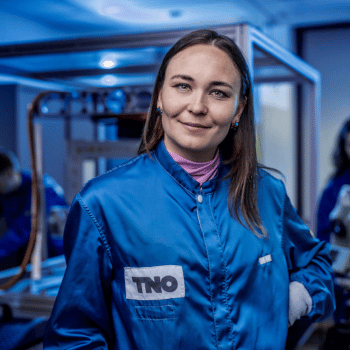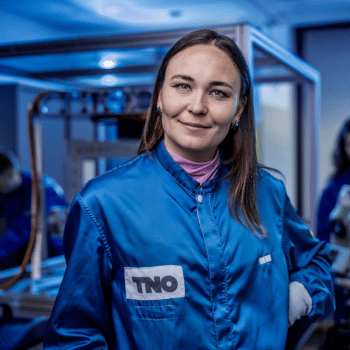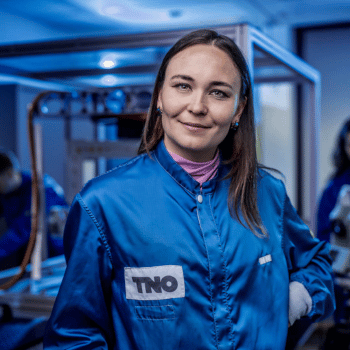
This is our time: Working on breakthroughs in laser satellite communication
As the data consumption of smart technologies skyrockets, the need for faster, more secure communication is greater than ever. The current radio frequency spectrum will not be able to handle all this data in the future. Latica Pletikapić Exle is working on a promising solution: laser satellite communication. She and her team are developing compact optical terminals to be placed in small satellites.
Laser satellite communication
Laser satellite communication uses light waves instead of radio waves, providing much higher capacity and faster connections. Optical communication is also less prone to interference, making it more reliable and secure for important applications, such as in the military domain. Laser satellite communication can therefore play a vital role in supporting our increasingly data-hungry world.
Latica is developing compact optical terminals that can be placed in small satellites - such as TNO’s CubeCAT, a powerful 10x10x10 cm terminal that enables bi-directional space-to-ground communication links between the satellite and an optical ground station.

‘We as TNO are at the forefront of this field and play an important role connecting research and commerce.’
Kees Buijsrogge, Director Space & Scientific Instrumentation at TNO: ‘TNO has been active in aerospace for 60 years, developing advanced instruments for telescopes and satellites. We’re now using that technical knowledge and experience in astronomy and Earth observation to force breakthroughs in laser satellite communication.’
‘A strongly positioned Dutch industry in optical satellite communication is crucial for Europe’s technological sovereignty within a strong NATO. It promotes faster and more secure broadband connectivity for both civilian and military applications.’
Latica continues: ‘But our CubeCAT terminal alone is not enough. Optical satellite communication is highly complex and requires a comprehensive system. Ultimately, a constellation of orbiting satellites, each equipped with advanced laser terminals, is needed. As well as a network of optical ground stations. All these components have to work together with precision. We’re therefore working with several specialised companies and knowledge institutions to make this a reality.’

‘The fact that the optical terminal developed by our team in our laboratory in Delft is now delivering successful results in orbit is amazing, isn’t it?’
Rapid industrialisation
Latica: ‘Globally, the number of organisations working on this technology is still limited. We as TNO are at the forefront of this field and play an important role connecting research and commerce. We’re developing the technology and working with Dutch companies to bring it to market as soon as possible.’
For example, TNO is working with Will Crowcombe, who, with FSO Instruments, will industrialise and commercialise TNO’s laser satellite communication technology under licence in the coming years. Check out Will’s story >.
Create the future
‘I’ve been working at TNO for a year now and it’s incredibly cool how we’re making the future possible here. It’s very inspiring to work with different people who all want to become even better at what they do. The fact that the optical terminal developed by our team in our laboratory in Delft is now delivering successful results in orbit is amazing, isn’t it?’

Want to become a time setter at TNO?
‘At TNO, you can do and learn a lot. In 6 to 10 years, I hope we’ll have matured the laser satellite communication market and be able to see the technology applied.’
